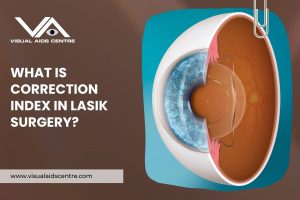Table of Contents
ToggleYes, you can get LASIK surgery if you have a -5.25 prescription.
However, the suitability for LASIK depends on various factors, such as the thickness of your cornea, the stability of your prescription, and your overall eye health.
For individuals with myopia (nearsightedness), LASIK has become a popular and effective solution for correcting vision. A -5.25 prescription indicates a high degree of myopia, but this falls well within the range of prescriptions that LASIK typically treats successfully. That said, the decision to get LASIK involves more than just your prescription strength.
Below, we explore how LASIK works, the eligibility criteria, and what you need to consider when weighing your options.
What is LASIK?
LASIK (Laser-Assisted in Situ Keratomileusis) is a type of refractive surgery designed to correct vision by reshaping the cornea using a laser. By altering the cornea’s shape, LASIK ensures that light entering your eye focuses properly on your retina, resulting in clear vision. It’s a quick, minimally invasive procedure with a high success rate, helping millions reduce or eliminate their dependency on glasses or contact lenses.
Understanding Myopia and a -5.25 Prescription
Myopia is a condition wherein distant objects appear blurry because light entering the eye focuses in front of the retina instead of directly on it. A prescription of -5.25 indicates a moderate to high degree of nearsightedness. Here’s what it means in practical terms:
- Moderate to High Myopia: The higher the number after the minus sign, the stronger your prescription and the more correction your eyes require.
- Impact on Vision: At a -5.25 prescription, you’ll likely find it difficult to see objects further than a couple of feet away without corrective lenses.
- LASIK Compatibility: The good news is that most LASIK platforms are designed to effectively correct prescriptions ranging from mild myopia to higher levels of myopia, provided other factors align.
LASIK Eligibility for a -5.25 Prescription
While a -5.25 prescription falls within the treatable range for LASIK, your prescription alone isn’t the only determining factor. Eye care specialists will assess several elements to determine your suitability:
1. Corneal Thickness
LASIK reshapes the cornea, so having sufficient corneal thickness is essential. If your cornea is too thin, it might not withstand the reshaping process. For those with inadequate corneal thickness, alternative procedures like PRK (Photorefractive Keratectomy) or SMILE (Small Incision Lenticule Extraction) might be recommended.
2. Prescription Stability
Your prescription must remain stable for a minimum of one year prior to considering LASIK. If your prescription is still changing, it indicates that your eye’s refractive error may continue to evolve, making you a poor candidate for the procedure at the moment.
3. Overall Eye Health
Good overall eye health is crucial for LASIK. Chronic dry eye, uncontrolled eye conditions (such as glaucoma or keratoconus), or previous eye infections may influence whether LASIK is a safe choice for you.
4. General Health Considerations
Certain health conditions, such as autoimmune diseases, uncontrolled diabetes, or pregnancy, may interfere with the healing process and could make LASIK unsuitable.
5. Age
While there’s no strict upper age limit for LASIK, most surgeons recommend the procedure only for individuals over the age of 18. Younger individuals usually have prescriptions that are still changing and might not be stable yet.
6. Prescription Limits
Most LASIK platforms correct myopia prescriptions up to -8.00 diopters, sometimes higher, as long as other eligibility requirements like corneal thickness are met. With a -5.25 prescription, you are well within this range.
The LASIK Procedure
Understanding the process can help you make an informed decision about whether LASIK is suitable for you. The LASIK procedure typically follows these steps:
1. Initial Consultation
Your eye surgeon will perform a series of tests to evaluate your corneal thickness, prescription stability, and general eye health.
2. Preparation
On the day of the surgery, numbing eye drops are applied to minimise discomfort. You’ll be asked to lie down while the rest of the process takes place.
3. Creating the Flap
A thin flap on the cornea is created using a microkeratome or a femtosecond laser. The flap is carefully elevated to expose the underlying corneal tissue.
4. Reshaping the Cornea
An excimer laser is used to reshape the cornea, correcting its curvature so that light focuses accurately on the retina.
5. Closing the Flap
The corneal flap is carefully repositioned, serving as a natural protective bandage. The flap will heal naturally without the need for stitches.
6. Post-Procedure Care
Recovery is usually rapid. Most patients notice improved vision within 24 hours, though full stabilisation may take a few weeks. During this period, it is essential to adhere strictly to your surgeon’s aftercare instructions.
Benefits of LASIK for Individuals with -5.25 Prescription
For patients with a moderate to high degree of myopia, LASIK offers several significant benefits beyond just visual improvement:
- Freedom from Glasses and Contacts
Imagine not having to worry about glasses fogging up or contacts drying out. LASIK can eliminate these everyday inconveniences.
- Quick Recovery Time
Most LASIK procedures are completed in less than 30 minutes, with minimal downtime. The majority of patients are able to resume work within one to two days.
- Proven Effectiveness
LASIK has one of the highest success rates among surgical procedures, with approximately 96% of patients achieving their desired vision correction.
- Improved Quality of Life
From sports to travel, everyday activities become easier and more enjoyable without the hassle of corrective lenses.
Potential Risks and Considerations
While LASIK is generally safe, it’s essential to be aware of potential risks and limitations:
- Temporary Side Effects
Some patients may experience dry eye, glare, halos, or fluctuations in vision during the recovery period. These are generally temporary in nature and tend to resolve independently.
- Not Everyone is a Candidate
If you have corneal thickness issues or other limiting factors, LASIK may not be recommended. However, there are alternatives like PRK or RLE (Refractive Lens Exchange) that might suit your needs.
- Future Vision Changes
While LASIK can correct your current prescription, it does not prevent future changes in your vision due to ageing or other conditions, such as presbyopia.
When to Consider LASIK with a -5.25 Prescription
You should consider LASIK if:
- You are over 18 years old and have fully stable vision.
- You are tired of relying on glasses or contact lenses and looking for a long-term solution.
- You meet the eligibility requirements for LASIK, as determined by a qualified ophthalmologist.
If you’re experiencing hesitation, take time to consult an ophthalmologist. They’ll ensure that LASIK is the right solution for you. Don’t hesitate to ask questions during your consultation to fully understand the benefits and risks.
Alternatives to LASIK
If LASIK is not suitable for your needs, you still have options. Alternatives include:
- Photorefractive Keratectomy (PRK)
Similar to LASIK but without creating a corneal flap, PRK is ideal for individuals with thin corneas.
- Small Incision Lenticule Extraction (SMILE)
A newer procedure with a quicker recovery time, suitable for moderate myopia.
- Refractive Lens Exchange (RLE)
An option for individuals over 40 who may also have presbyopia.
- Orthokeratology Lenses
Special contact lenses that temporarily reshape the cornea while you sleep.
Final Thoughts
For those with a -5.25 prescription, LASIK can be an effective solution, but eligibility depends on individual factors like corneal thickness, prescription stability, and general eye health. Consulting an experienced ophthalmologist is the first step to determining if LASIK is suitable for you.
If you’re ready to take the next step towards clear, glasses-free vision, book a consultation with an eye care specialist today. LASIK could transform how you see the world—literally!













